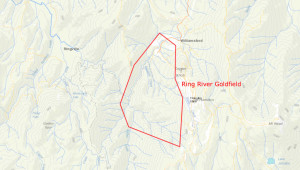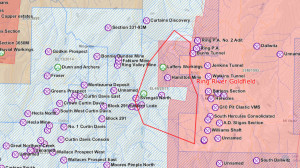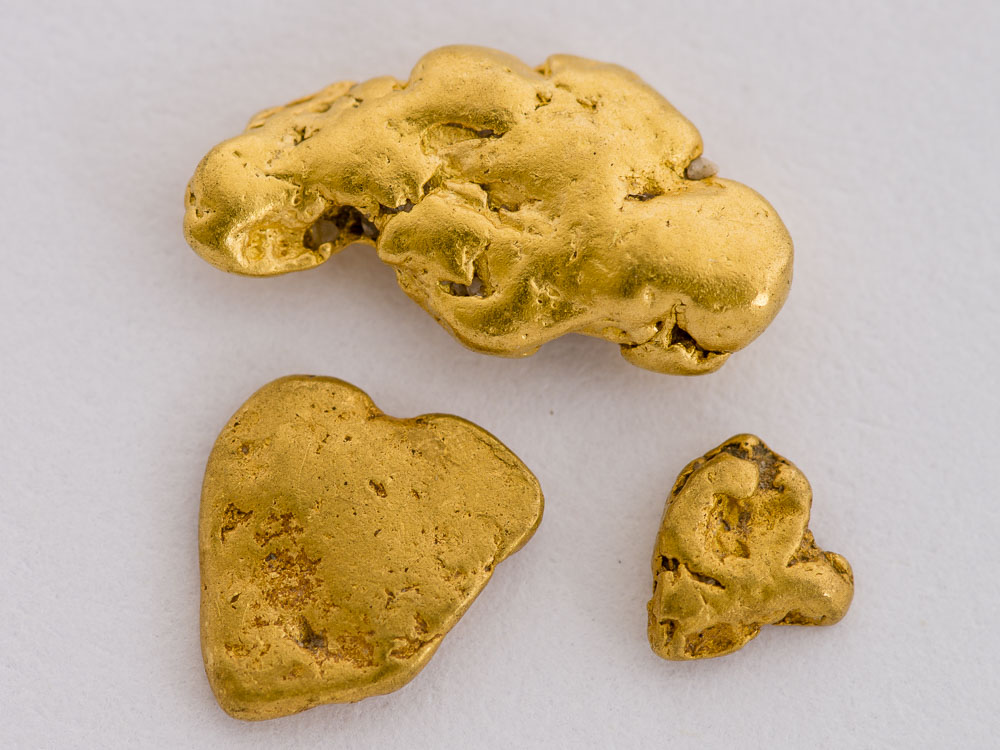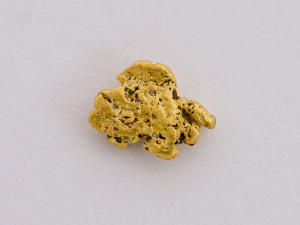In terms of single-mine output, no Tasmanian gold mine can surpass the Tasmania Mine at Beaconsfield, in the north-east, which has so far had a total production of well over a million ounces.
However, in terms of widespread finds of worthwhile deposits in Tasmania, west coast gold comes up clearly on top.
Gold was known from the Arthur / Hellyer system since at least 1860. Minor workings were carried out in the Hellyer by Europeans and Chinese in the 1870s. In spite of this, the area remained very remote. Due to the lack of roads and tracks, no major discoveries occurred till the development of the Corinna goldfield in the 1880s.
Rosebery – Zeehan – Dundas
After the start of tin mining in Mount Bischoff, prospecting for west coast gold picked up. The Corinna goldfield also stimulated gold prospecting in the west coast generally.
Gold was known in small amounts from many west coast streams, and further south in the Queenstown area there were rushes in the 1880s that I’ll cover in another post.
The Rosebery – Zeehan – Dundas area is renowned mainly for its silver-lead, zinc and tin deposits. However, some decent finds of gold were also made. The main gold workings in this part of the west coast were in the Ring River goldfield and Melba Flats. Interestingly, both of these produced some sizeable nuggets. You can find some of the early records of these in my gold nugget database. Other minor workings dotted the area, from the Wilson River to the Farrell Rivulet area.
The Ring River goldfield
In the early days of developement of the Zeehan mines, the main means of access were by ship through either Trial Harbour, or later, Strahan. The Emu Bay railway line to Zeehan was being built in the early 1890s, at a time of severe depression in the mining industry. Gold was discovered in the western slopes of Mount Read, at the headwaters of the Ring River.

Ring River goldfield. Map courtesy of MRTmap
Since the mining depression meant that there were a lot of people in Zeehan out of work, a rush quickly developed. The main workings in the Ring River goldfield were along the small creeks draining the eastern side of the Ring River valley. These include Scott, Baker and Booker Creeks, and Conliffe Creek. An area of important workings was the perched alluvial along the ridge separating Baker and Booker Creeks, known as the “Terrace Claim” in early reports. As the small deposits in the creeks became exhausted, attention turned to the bed of the Ring River itself. This last one was hard to work due to work, as the river spends such a high proportion of the year with very high water levels.
The Ring River goldfield today
If you’re keen to find some west coast gold, and you’re thinking of heading to the Ring River area, be aware that it’s pretty much totally covered in tenements.

November 2015 Ring River tenements. Map courtesy of MRTmap
As of the time of writing (Nov 2015), about 2/3 of the historical goldfield are inside the Rosebery mine lease, with signposts warning against trespassing. The rest is under a couple of different exploration licence areas.
Unlike other goldfields, access is pretty easy, as the road to Williamsford puts you right in the middle of the action, and the Montezuma Falls track follows the valley right along the Ring River, crossing most of the major creeks that were worked for gold back in the 1890s. Your reward could be a decent nugget: the largest two found in the area weighed 10.25 and 4 ounces.
My experience of the creeks that formed the main part of the Ring River goldfield is that they’re pretty worked out. It can be hard to find colour in Booker Creek, and Baker Creek is pretty choked up: it became the conduit down which a lot of the junk coming off the Hercules mine was sent down. Your best bet would be to work crevices that the old timers missed, if you can find any. The terrace claim is pretty steep and scrubby, but might be worth a go. I don’t know of any modern finds from in there. My best find in the area of the historic goldfield was the little nugget pictured here. It was covered in brown ironstone and needed a good clean. Keep in mind that gold can be found in many streams in the general Dundas area, and some of them might not have been payable enough to get a decent working in the past. It’s often these streams that have more gold in them today: the old timers usually did a pretty good job of cleaning out the gold in the streams that they DID work. The thre nuggets in the featured image at the top are from a small, nameless creek also within the Dundas area.
Have you found a decent spot for panning in the Ring River goldfield area and you don’t mind sharing it? Do you find the posts useful, or want to leave some feedback? If you like the content at Apple Isle Prospector, feel free to get in contact, or leave a comment. If you enjoyed this article, then let others know by sharing it on Facebook or liking our Facebook or Twitter pages:



I find your post informative as I’m new to Metal Detecting and Prospecting.
thanks
Thanks Brent, I’m glad you find them useful!
Where would be the best place to take a 7 &8 yrs old boy and girl to prospect please we will be in Richmond on the 15-17 April any ideas would be greatly appreciated
Thank you Julia
Hi Julia,
I really don’t know what you have in mind. Friends of mine with young children really enjoy fossicking for agates and petrified wood around the diggings at Lune River. If you want to take them gold panning it’s a bit harder, there is nothing really close to Richmond. Our goldfields are mostly on the west coast and the north east.
Good luck!
TP
What can you tell us about the whyte river…?
Gold was discovered there in the late 1870s, worked through to the depression (1930s). Some large dredging operations were tried unsuccessfully in the area. Have a look at my Corinna Goldfields post: http://appleisleprospector.com/the-corinna-gold-fields/
Hi there . Ive just started getting the bug .. gold that is. Ive been doing a bit of digging around on the net about the ring river and it is suposed to have a high level of flour gold in black sand , that you cant see.? Do you have any knowledge about that. In the states they use a magnet to get rid of the ferris metals and then heat the black sand with a flux in a crucible to melt the gold, has anyone here done that to your knowledge. I know you said we could only use a pan. What about micron mesh , say bubble bags. That must sort out the sand from the other elements. I would love to hear you feedback on this cheers Andrew
Hi Andrew,
I’ve found nuggets in the Ring River area, there’s normal sized gold in there as well. Historically the area produced nuggets up to 11 ounces or so. Fine flour gold is not that hard to pan down to a concentrate. I usually just use a 1/8th inch gemstone sieve to separate the gravels, and then pan down the fines to a concentrate that I put into a bucket.
I then take the bucket home to separate at lesiure.
Good luck!
Hi there again thanks for the great info most helpfull. I have just ordered a sieve set and a couple pans, just have to get my prospectors license and im done. Driving from roseberry the first bridge you get to that crosses the ring river’ ive heard reports that it holds a lot of flour gild. I just sont know if its on a tenement or not. Ive looked at mrt and looks like its just out of one. Just wanted to know if you have tried there before.
Kind regards
Andrew
Hi Andrew,
No, I haven’t had much of a look in the Ring River area. Much of it is inside the Rosebery mine lease, so make sure you check where you’re going.
Cheers,
Miguel